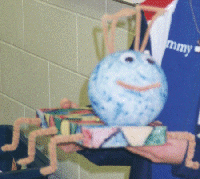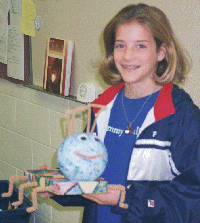I've got that Geometry Bug!
A Day
in the Life of my Geometry Bug
 My geometry bug is called the Anglotic bug. I named it
"Anglotic" because there are many different shapes in it, which
contain many angles in them. This bug is completely made up of shapes like squares,
triangles, spheres, rhombuses, rectangles, trapezoids, and more. Its head is a
sphere because, well, most heads are shaped that way. Its antennae are
triangles and its body is rectangular because I thought that it would look neat
that way. Its entire body is covered in colors and shapes. This bug is a very
interesting one.
My geometry bug is called the Anglotic bug. I named it
"Anglotic" because there are many different shapes in it, which
contain many angles in them. This bug is completely made up of shapes like squares,
triangles, spheres, rhombuses, rectangles, trapezoids, and more. Its head is a
sphere because, well, most heads are shaped that way. Its antennae are
triangles and its body is rectangular because I thought that it would look neat
that way. Its entire body is covered in colors and shapes. This bug is a very
interesting one.
The
Anglotic bug lives in the tropical rain forest. Since there are many colorful
plants and animals there, the Anglotic bug’s outer- look is perfect for
camouflage. This is important so that it can stay hidden as much as possible.
The camouflage is also important for mimicry, so that using its bright colors,
the Anglotic bug warns animals like birds to stay away; that it isn’t good to
eat. The Anglotic bug can run at a range near the speed of an ant. It is also
light- weight enough so it can skim water surfaces when cohesion is occurring.
This bug is rather strong also. It can hold and carry things up to 8 times its
own weight. The Anglotic bug spends most of its day in search of food. It is an
herbivore, which means it eats greens like grass, plants, and weeds. At times
when it is not looking for food, it is either escaping predators or finding a
new place to live. It does this because it is always on the move, and once it
starts to travel, it does not go back. This means that whenever it isn’t
eating, travelling, or saving its own life, it is setting up a temporary home.
 Even though the Anglotic bug seems to have a fairly simple life, it
does face some challenges. Since it is bigger than an ant, it cannot fit into
some things that an ant would be able to. It is able to fit into short, wide
areas when needed, but it is unable to get through areas that are narrow due to
its long, flat, wide back. Because of this problem, it is one way for the
Anglotic bug to get killed.
Even though the Anglotic bug seems to have a fairly simple life, it
does face some challenges. Since it is bigger than an ant, it cannot fit into
some things that an ant would be able to. It is able to fit into short, wide
areas when needed, but it is unable to get through areas that are narrow due to
its long, flat, wide back. Because of this problem, it is one way for the
Anglotic bug to get killed.
The
Anglotic bug is an interesting insect. It is colorful, geometrical, and neat to
learn about (even though it doesn’t actually exist). It has many shapes and
colors, and faces some small day-to-day problems. The Anglotic bug leads a fun
and interesting bug’s life.
Project Description
Research Questions
Student Work